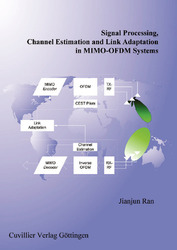| Fachbereiche | |
|---|---|
| Buchreihen (96) |
1378
|
| Nachhaltigkeit |
3
|
| Gesundheitswesen |
1
|
| Geisteswissenschaften |
2364
|
| Naturwissenschaften |
5406
|
| Ingenieurwissenschaften |
1793
|
| Allgemeine Ingenieurwissenschaften | 292 |
| Maschinenbau und Verfahrenstechnik | 862 |
| Elektrotechnik | 686 |
| Bergbau- und Hüttenwesen | 30 |
| Architektur und Bauwesen | 75 |
| Allgemein |
98
|
|
Leitlinien Unfallchirurgie
5. Auflage bestellen |
|
Erweiterte Suche
Signal Processing, Channel Estimation and Link Adaptation in MIMO-OFDM Systems
Jianjun Ran (Autor)Vorschau
Inhaltsverzeichnis, Datei (24 KB)
Leseprobe, Datei (200 KB)
The emerging wireless communication systems, such as cellular communications systems and wireless net-works, are changing the life style nowadays dramatically. The prospect of modern wireless communication systems is very attractive by declaring the ability of ubiquitous access to information with high-quality and high-speed service.
The Orthogonal Frequency Division Multiplexing (OFDM) technique is one promising candidate for the $4^{th}$ generation wireless systems, due to its merits of high flexibility and low equalization complexity for wideband wireless communication applications. To further enhance the communication system capacity and reliability, multiple antenna techniques can be integrated into OFDM systems.
As a preliminary step, the physical characteristics of wideband radio channels and the channel modeling issue are addressed. The channel capacity with multiple antennas is presented by considering both cases of ideal and practical estimated channel state information (CSI) in the system.
The fundamentals of the OFDM transmission technique are introduced. With the OFDM transmission structu-re the frequency-selective wideband radio channel is decomposed into a set of parallel subcarriers, and each subcarrier can be treated as a flat-fading narrowband channel.
Several Multiple-Input-Multiple-Output (MIMO) technologies are discussed, in the scope of subcarrier-based MIMO encoding and decoding within the MIMO-OFDM transceiver structure, i.\ e.\ integrate the MIMO signal processing algorithms into a wideband OFDM system, where each OFDM subcarrier is regarded individually as a narrowband flat-fading subsystem with the Discrete Fourier Transform (DFT) and Inverse Discrete Fou-rier Transform (IDFT). The simulation results and analysis are presented under various radio channel condi-tions with ideal CSI.
For practical reasons, channel estimation is necessary for coherent-detection MIMO-OFDM systems. The Pilot-based Channel Estimation (PBCE) schemes are implemented to evaluate the system performance with the realistically estimated CSI. With estimated CSI for MIMO encoding/decoding and data symbol detection, the system performance is reasonably degraded. The system performance results with estimated CSI are presented, and the impact of channel estimation errors is analyzed.
In order to ensure a reliable and flexible data transmission in MIMO-OFDM systems, the indicator-based link adaptation procedure is employed to optimize the system throughput by selecting a proper Transmission Mode™ according to the instantaneous channel conditions. The Transmission Mode Selection (TMS) procedure with two-dimensional (2D) indicators is developed. A set of indicator candidates and their appro-ximation functions are proposed. With the indicator simulation results and the proposed TMS procedure for MIMO-OFDM systems, the average system throughput results are illustrated for both the conventional link adaptation method and the proposed 2D indicator-based TMS approach.
Finally, the general system performance results of MIMO-OFDM systems are summarized. Arguments and suggestions are further made on how to design a MIMO-OFDM system in various wideband wireless com-munication applications.
| ISBN-13 (Printausgabe) | 3867276498 |
| ISBN-13 (Printausgabe) | 9783867276498 |
| ISBN-13 (E-Book) | 9783736926493 |
| Sprache | Englisch |
| Seitenanzahl | 162 |
| Auflage | 1 |
| Band | 0 |
| Erscheinungsort | Göttingen |
| Promotionsort | Hamburg-Harburg |
| Erscheinungsdatum | 24.07.2008 |
| Allgemeine Einordnung | Dissertation |
| Fachbereiche |
Elektrotechnik
|
| Schlagwörter | MIMO, OFDM, Channel Estimation, Link Adaption. |








